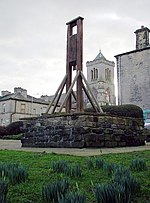St Mary's Church, Halifax
19th-century Roman Catholic church buildings in the United KingdomBuildings and structures in Halifax, West YorkshireGothic Revival architecture in West YorkshireGothic Revival church buildings in EnglandRoman Catholic Diocese of Leeds ... and 2 more
Roman Catholic churches completed in 1839Roman Catholic churches in West Yorkshire

St Mary's Church or St Marie's Church is a Roman Catholic Parish church in Halifax, West Yorkshire. It was built from 1836 to 1839. It is situated on the corner of Gibbet Street and Clarence Street, next to Burdock Way. It is the first Post-Reformation Roman Catholic church built in Halifax.
Excerpt from the Wikipedia article St Mary's Church, Halifax (License: CC BY-SA 3.0, Authors, Images).St Mary's Church, Halifax
Gibbet Street, Calderdale Pellon
Geographical coordinates (GPS) Address Website External links Nearby Places Show on map
Geographical coordinates (GPS)
| Latitude | Longitude |
|---|---|
| N 53.723256 ° | E -1.868257 ° |
Address
St Mary's RC Church
Gibbet Street
HX1 5DH Calderdale, Pellon
England, United Kingdom
Open on Google Maps








